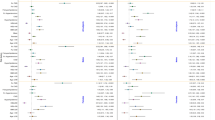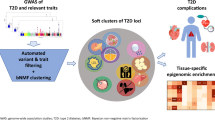Abstract
Four single nucleotide polymorphisms (SNPs, rs2237892, rs2237895, rs2237897, rs2283228) in KCNQ1 are associated with type 2 diabetes mellitus in different ancestral groups. We investigated whether these 4 genetic markers are determinants of type 2 diabetes and premature coronary artery disease (CAD) in a Chinese population. We studied 398 consecutive patients, including 180 with coronary stenosis ≥50% or previous myocardial infarction (male <55 years, female <65 years) and 218 controls without documented CAD. CAD cases and controls were genotyped for 4 SNPs by using the ligase detection reaction method. The 3 genotypes AA, AC, and CC were present in rs2283228 and rs2237895, and the 3 genotypes CC, CT, TT were present in rs2237897 and rs2237892. No differences were found in genotype distribution and allele frequencies of these 4 SNPs between subjects with and without type 2 diabetes. Logistic regression showed that the risk of premature CAD in subjects carrying the CC genotype at rs2237892 was reduced by 90% in relation to individuals carrying the TT genotype (OR = 0.100, 95% CI: 0.018–0.564, P = 0.009). The association of other 3 SNPs with premature CAD could not be detected, nor did there exist any association of these 4 SNPs among groups of patients with 0, 1, 2, and 3-vessel disease (all P > 0.05). Our data implicate rs2237892 in KCNQ1 as a protective gene variant against premature CAD and we couldn’t replicate any association of these 4 SNPs with T2DM or extent of coronary lesions in a Chinese population.
Similar content being viewed by others
References
He J, Gu D, Wu X et al (2005) Major causes of death among men and women in China. N Engl J Med 353:1124–1134
Marenberg ME, Risch N, Berkman LF et al (1994) Genetic susceptibility to death from coronary heart disease in a study of twins. N Engl J Med 330:1041–1046
Helgadottir A, Thorleifsson G, Manolescu A et al (2007) A common variant on chromosome 9p21 affects the risk of myocardial infarction. Science 316:1491–1493
McPherson R, Pertsemlidis A, Kavaslar N et al (2007) A common allele on chromosome 9 associated with coronary heart disease. Science 316:1488–1491
Samani NJ, Erdmann J, Hall AS et al (2007) WTCCC and the cardiogenics consortium. Genomewide association analysis of coronary artery disease. N Engl J Med 357:443–453
Chen Z, Qian Q, Ma G et al (2009) A common variant on chromosome 9p21 affects the risk of early-onset coronary artery disease. Mol Biol Rep 36:889–893
Akosah KO, Gower E, Groon L et al (2000) Mild hypercholesterolemia and premature heart disease: do the national criteria underestimate disease risk? J Am Coll Cardiol 35:1178–1184
Gurevitz O, Jonas M, Boyko V et al (2000) Clinical profile and long-term prognosis of women < or = 50 years of age referred for coronary angiography for evaluation of chest pain. Am J Cardiol 85:806–809
Mori Y, Otabe S, Dina C et al (2002) Genome-wide search for type 2 diabetes in Japanese affected sib-pairs confirms susceptibility genes on 3q, 15q, and 20q and identifies two new candidate loci on 7p and 11p. Diabetes 51:1247–1255
Nawata H, Shirasawa S, Nakashima N et al (2004) Genome-wide linkage analysis of type 2 diabetes mellitus reconfirms the susceptibility locus on 11p13–p12 in Japanese. J Hum Genet 49:629–634
Unoki H, Takahashi A, Kawaguchi T et al (2008) SNPs in KCNQ1 are associated with susceptibility to type 2 diabetes in East Asian and European populations. Nat Genet 40:1098–1102
Yasuda K, Miyake K, Horikawa Y et al (2008) Variants in KCNQ1 are associated with susceptibility to type 2 diabetes mellitus. Nat Genet 40:1092–1097
Diabetes Genetics Initiative of Broad Institute of Harvard and MIT, Lund University, Novartis Institutes of BioMedical Research, Saxena R, Voight BF, Lyssenko V et al (2007) Genome-wide association analysis identifies loci for type 2 diabetes and triglyceride levels. Science 316:1331–1336
Zeggini E, Weedon MN, Lindgren CM et al (2007) Wellcome trust case control consortium (WTCCC), McCarthy MI, Hattersley AT. Replication of genome-wide association signals in UK samples reveals risk loci for type 2 diabetes. Science 316:1336–1340
Tan JT, Nurbaya S, Gardner D et al (2009) Genetic variation in KCNQ1 associates with fasting glucose and beta-cell function: a study of 3, 734 subjects comprising three ethnicities living in Singapore. Diabetes 58:1445–1449
Hu C, Wang C, Zhang R et al. (2009) Variations in KCNQ1 are associated with type 2 diabetes and beta cell function in a Chinese population. Diabetologia Mar 24. [Epub ahead of print]
Kareinen A, Viitanen L, Halonen P et al (2001) Cardiovascular risk factors associated with insulin resistance cluster in families with early-onset coronary artery disease. Arterioscler Thromb Vasc Biol 21:1346–1352
World Health Organization (1990) MONICA manual; CVD/MNC. World Health Organization, Geneva. Switzerland
Favis R, Day JP, Gerry NP et al (2000) Universal DNA array detection of small insertions and deletions in BRCA1 and BRCA2. Nat Biotechnol 18:561–564
Xiao Z, Xiao J, Jiang Y et al (2006) A novel method based on ligase detection reaction for low abundant YIDD mutants detection in hepatitis B virus. Hepatol Res 34:150–155
Ullrich S, Su J, Ranta F et al (2005) Effects of I(Ks) channel inhibitors in insulin-secreting INS-1 cells. Pflugers Arch 451:428–436
Fukushima M, Suzuki H, Seino Y (2004) Insulin secretion capacity in the development from normal glucose tolerance to type 2 diabetes. Diabetes Res Clin Pract 66:S37–S43
Schunkert H, Götz A, Braund P et al (2008) Cardiogenics consortium. Repeated replication and a prospective meta-analysis of the association between chromosome 9p21.3 and coronary artery disease. Circulation 117:1675–1684
Shen GQ, Li L, Rao S et al (2008) Four SNPs on chromosome 9p21 in a South Korean population implicate a genetic locus that confers high cross-race risk for development of coronary artery disease. Arterioscler Thromb Vasc Biol 28:360–365
Abdullah KG, Li L, Shen GQ et al (2008) Four SNPS on chromosome 9p21 confer risk to premature, familial CAD and MI in an American Caucasian population (GeneQuest). Ann Hum Genet 72(Pt 5):654–657
Acknowledgments
This study was supported by grants from the Ministry of Education of P. R. China and the Nanjing Scientific Development Project (2006ZD016).
Author information
Authors and Affiliations
Corresponding author
Rights and permissions
About this article
Cite this article
Chen, Z., Zhang, X., Ma, G. et al. Association study of four variants in KCNQ1 with type 2 diabetes mellitus and premature coronary artery disease in a Chinese population. Mol Biol Rep 37, 207–212 (2010). https://doi.org/10.1007/s11033-009-9597-0
Received:
Accepted:
Published:
Issue Date:
DOI: https://doi.org/10.1007/s11033-009-9597-0




